Accounting for Managers: Financial Analysis of Pacific Telemet Ltd
VerifiedAdded on 2021/11/01
|12
|1438
|102
Report
AI Summary
This report analyzes financial data for Pacific Telemet Ltd., focusing on accounting for managers. It examines three proposals for increasing profitability, evaluating sales, costs, and profits under each scenario. The report calculates profits under current circumstances and compares them to the proposed alternatives, considering factors like selling price, variable costs, and advertisement expenses. It also addresses special order decisions, calculating bid prices based on spare capacity and potential profit or loss, considering both quantitative and qualitative factors. The analysis includes cost statements and emphasizes the importance of balancing profitability with product quality and customer satisfaction. The report provides insights into financial decision-making, highlighting the impact of various strategies on the company's financial performance and the importance of considering both quantitative and qualitative factors in pricing and production decisions.
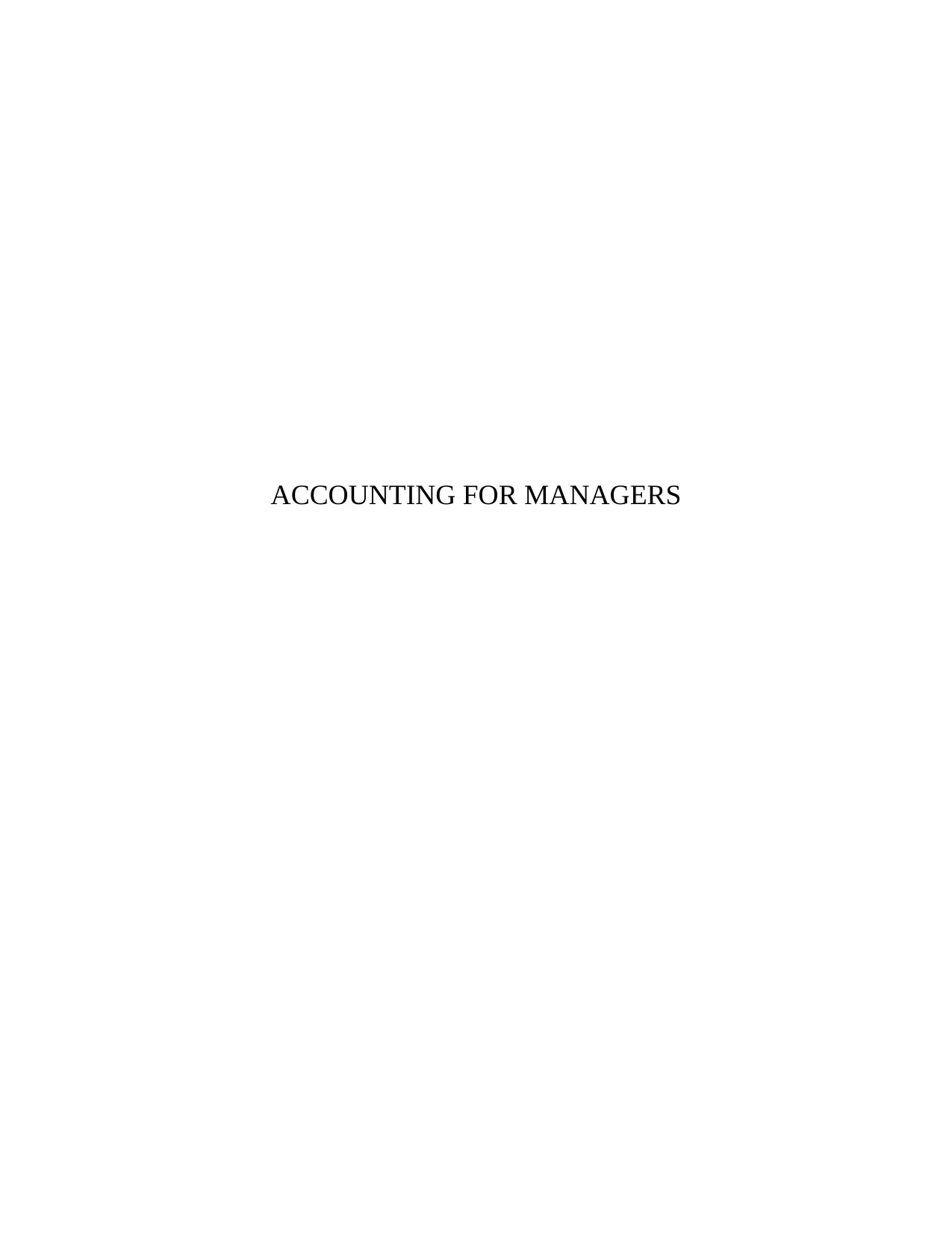
ACCOUNTING FOR MANAGERS
Paraphrase This Document
Need a fresh take? Get an instant paraphrase of this document with our AI Paraphraser
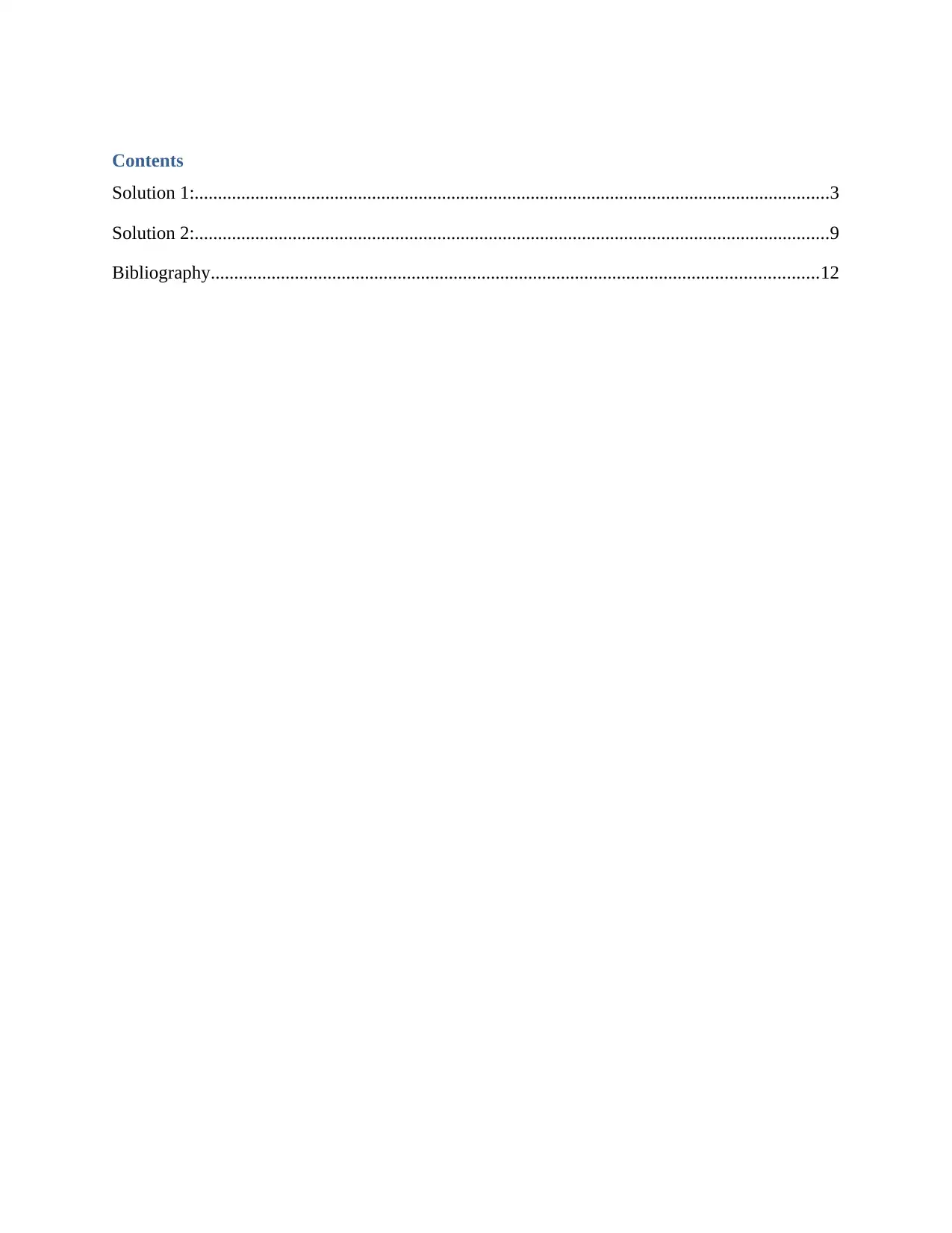
Contents
Solution 1:........................................................................................................................................3
Solution 2:........................................................................................................................................9
Bibliography..................................................................................................................................12
Solution 1:........................................................................................................................................3
Solution 2:........................................................................................................................................9
Bibliography..................................................................................................................................12
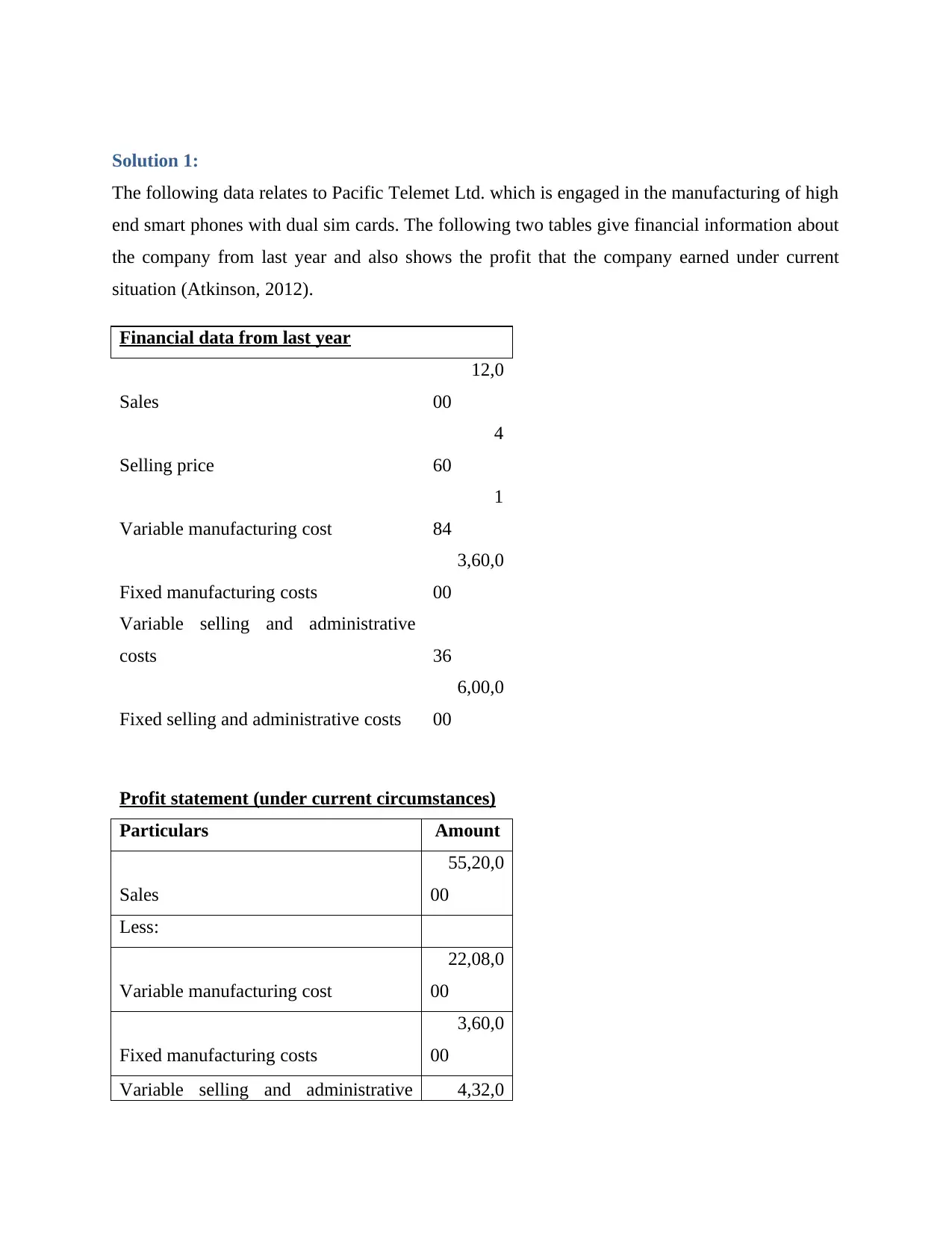
Solution 1:
The following data relates to Pacific Telemet Ltd. which is engaged in the manufacturing of high
end smart phones with dual sim cards. The following two tables give financial information about
the company from last year and also shows the profit that the company earned under current
situation (Atkinson, 2012).
Financial data from last year
Sales
12,0
00
Selling price
4
60
Variable manufacturing cost
1
84
Fixed manufacturing costs
3,60,0
00
Variable selling and administrative
costs 36
Fixed selling and administrative costs
6,00,0
00
Profit statement (under current circumstances)
Particulars Amount
Sales
55,20,0
00
Less:
Variable manufacturing cost
22,08,0
00
Fixed manufacturing costs
3,60,0
00
Variable selling and administrative 4,32,0
The following data relates to Pacific Telemet Ltd. which is engaged in the manufacturing of high
end smart phones with dual sim cards. The following two tables give financial information about
the company from last year and also shows the profit that the company earned under current
situation (Atkinson, 2012).
Financial data from last year
Sales
12,0
00
Selling price
4
60
Variable manufacturing cost
1
84
Fixed manufacturing costs
3,60,0
00
Variable selling and administrative
costs 36
Fixed selling and administrative costs
6,00,0
00
Profit statement (under current circumstances)
Particulars Amount
Sales
55,20,0
00
Less:
Variable manufacturing cost
22,08,0
00
Fixed manufacturing costs
3,60,0
00
Variable selling and administrative 4,32,0
⊘ This is a preview!⊘
Do you want full access?
Subscribe today to unlock all pages.

Trusted by 1+ million students worldwide
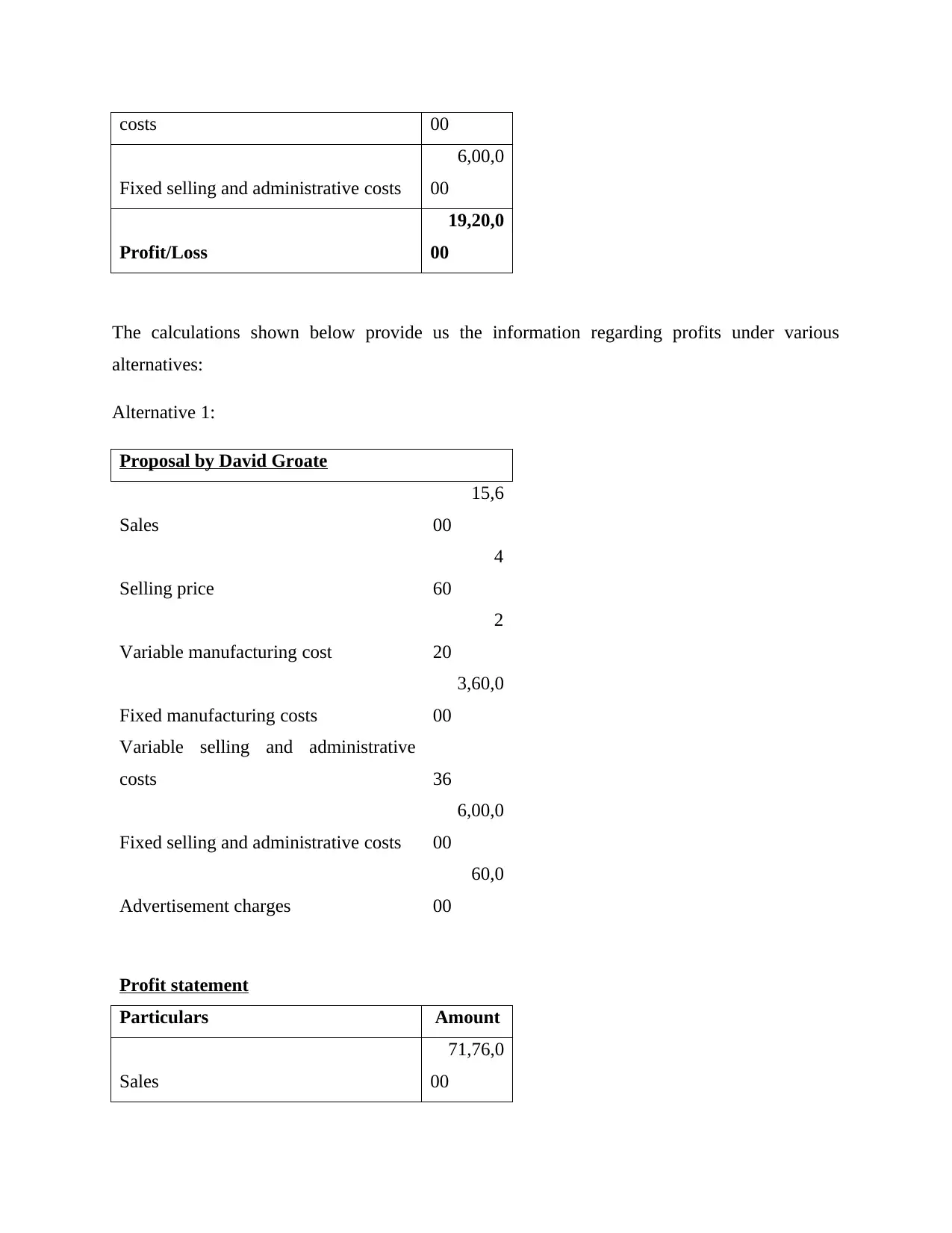
costs 00
Fixed selling and administrative costs
6,00,0
00
Profit/Loss
19,20,0
00
The calculations shown below provide us the information regarding profits under various
alternatives:
Alternative 1:
Proposal by David Groate
Sales
15,6
00
Selling price
4
60
Variable manufacturing cost
2
20
Fixed manufacturing costs
3,60,0
00
Variable selling and administrative
costs 36
Fixed selling and administrative costs
6,00,0
00
Advertisement charges
60,0
00
Profit statement
Particulars Amount
Sales
71,76,0
00
Fixed selling and administrative costs
6,00,0
00
Profit/Loss
19,20,0
00
The calculations shown below provide us the information regarding profits under various
alternatives:
Alternative 1:
Proposal by David Groate
Sales
15,6
00
Selling price
4
60
Variable manufacturing cost
2
20
Fixed manufacturing costs
3,60,0
00
Variable selling and administrative
costs 36
Fixed selling and administrative costs
6,00,0
00
Advertisement charges
60,0
00
Profit statement
Particulars Amount
Sales
71,76,0
00
Paraphrase This Document
Need a fresh take? Get an instant paraphrase of this document with our AI Paraphraser
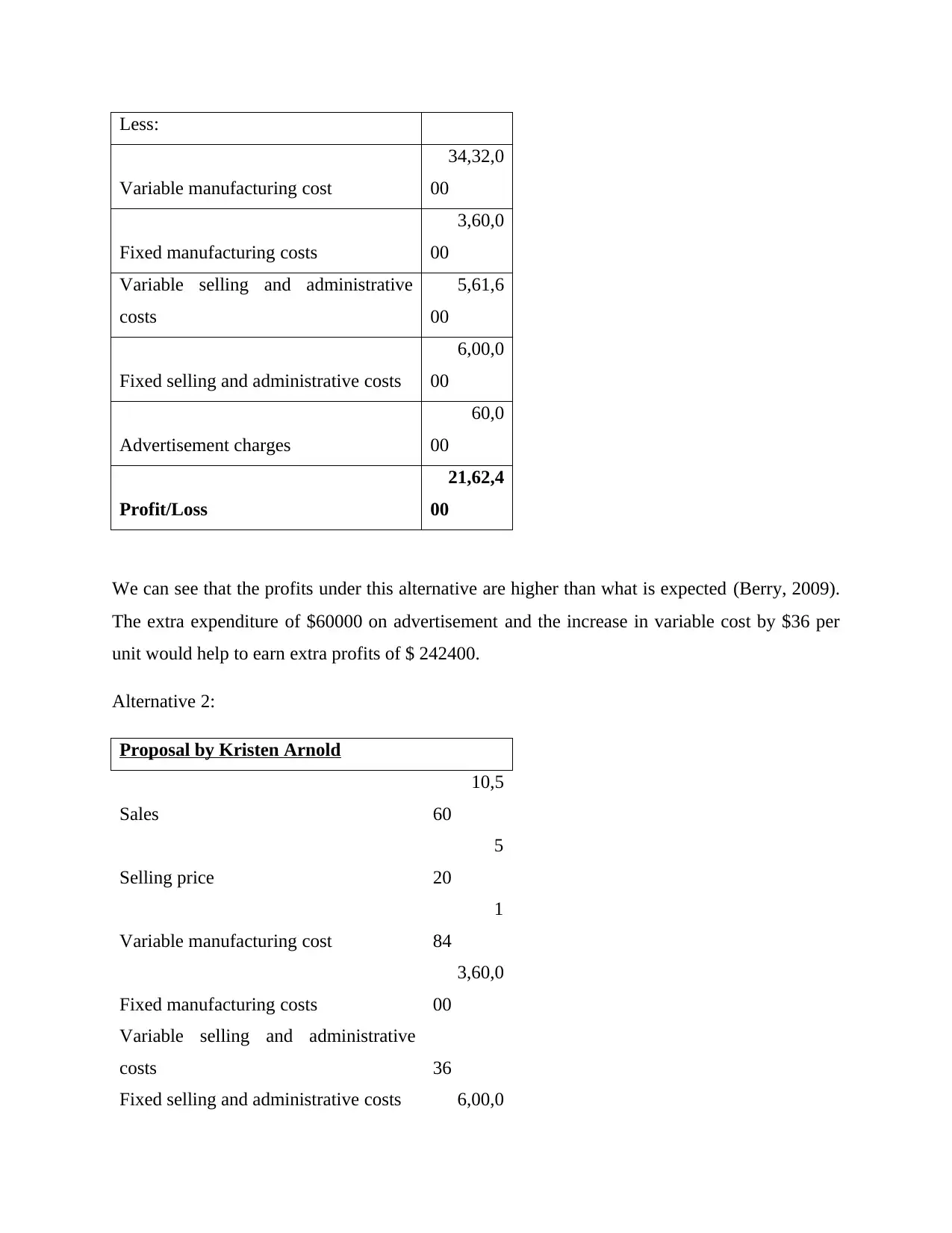
Less:
Variable manufacturing cost
34,32,0
00
Fixed manufacturing costs
3,60,0
00
Variable selling and administrative
costs
5,61,6
00
Fixed selling and administrative costs
6,00,0
00
Advertisement charges
60,0
00
Profit/Loss
21,62,4
00
We can see that the profits under this alternative are higher than what is expected (Berry, 2009).
The extra expenditure of $60000 on advertisement and the increase in variable cost by $36 per
unit would help to earn extra profits of $ 242400.
Alternative 2:
Proposal by Kristen Arnold
Sales
10,5
60
Selling price
5
20
Variable manufacturing cost
1
84
Fixed manufacturing costs
3,60,0
00
Variable selling and administrative
costs 36
Fixed selling and administrative costs 6,00,0
Variable manufacturing cost
34,32,0
00
Fixed manufacturing costs
3,60,0
00
Variable selling and administrative
costs
5,61,6
00
Fixed selling and administrative costs
6,00,0
00
Advertisement charges
60,0
00
Profit/Loss
21,62,4
00
We can see that the profits under this alternative are higher than what is expected (Berry, 2009).
The extra expenditure of $60000 on advertisement and the increase in variable cost by $36 per
unit would help to earn extra profits of $ 242400.
Alternative 2:
Proposal by Kristen Arnold
Sales
10,5
60
Selling price
5
20
Variable manufacturing cost
1
84
Fixed manufacturing costs
3,60,0
00
Variable selling and administrative
costs 36
Fixed selling and administrative costs 6,00,0
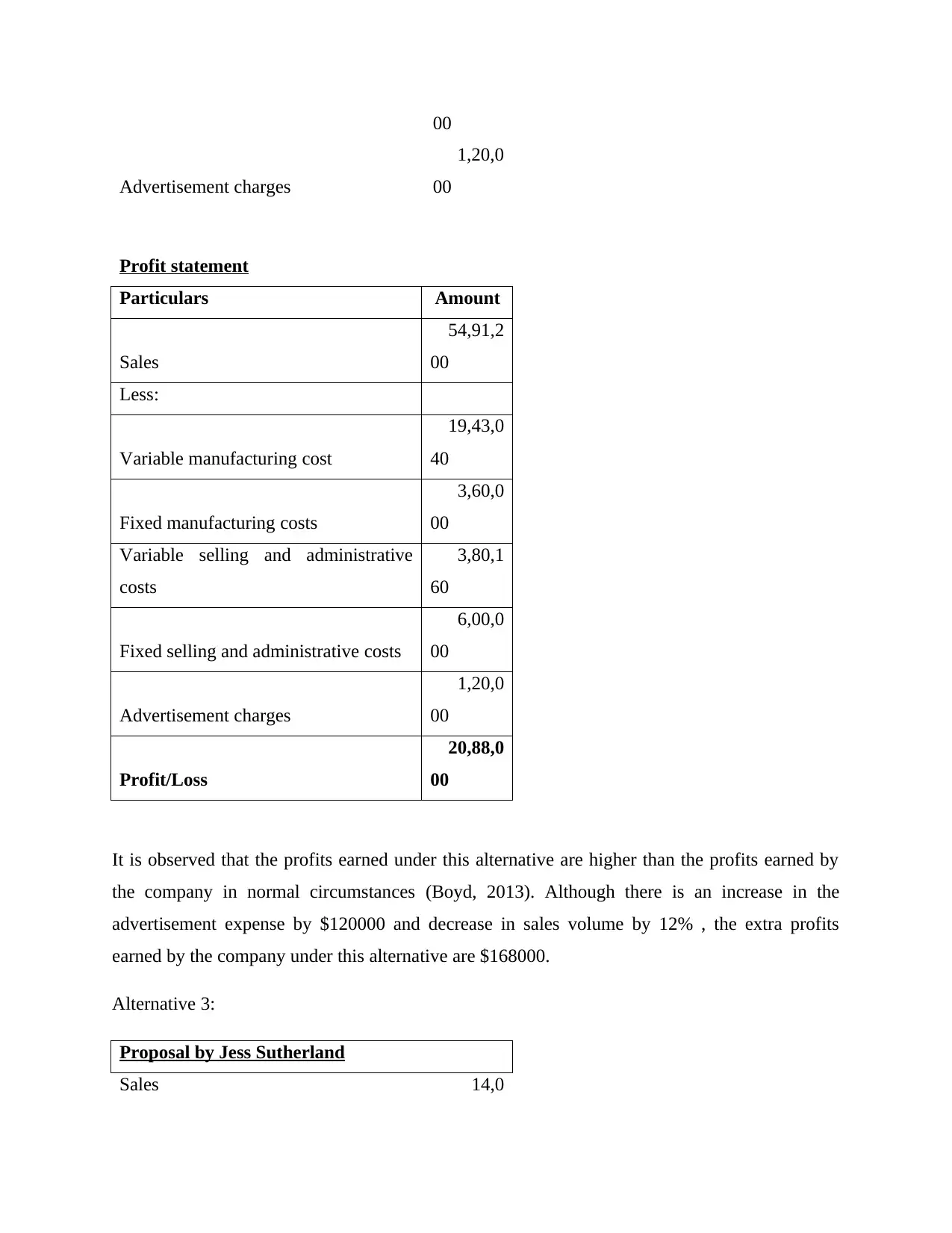
00
Advertisement charges
1,20,0
00
Profit statement
Particulars Amount
Sales
54,91,2
00
Less:
Variable manufacturing cost
19,43,0
40
Fixed manufacturing costs
3,60,0
00
Variable selling and administrative
costs
3,80,1
60
Fixed selling and administrative costs
6,00,0
00
Advertisement charges
1,20,0
00
Profit/Loss
20,88,0
00
It is observed that the profits earned under this alternative are higher than the profits earned by
the company in normal circumstances (Boyd, 2013). Although there is an increase in the
advertisement expense by $120000 and decrease in sales volume by 12% , the extra profits
earned by the company under this alternative are $168000.
Alternative 3:
Proposal by Jess Sutherland
Sales 14,0
Advertisement charges
1,20,0
00
Profit statement
Particulars Amount
Sales
54,91,2
00
Less:
Variable manufacturing cost
19,43,0
40
Fixed manufacturing costs
3,60,0
00
Variable selling and administrative
costs
3,80,1
60
Fixed selling and administrative costs
6,00,0
00
Advertisement charges
1,20,0
00
Profit/Loss
20,88,0
00
It is observed that the profits earned under this alternative are higher than the profits earned by
the company in normal circumstances (Boyd, 2013). Although there is an increase in the
advertisement expense by $120000 and decrease in sales volume by 12% , the extra profits
earned by the company under this alternative are $168000.
Alternative 3:
Proposal by Jess Sutherland
Sales 14,0
⊘ This is a preview!⊘
Do you want full access?
Subscribe today to unlock all pages.

Trusted by 1+ million students worldwide
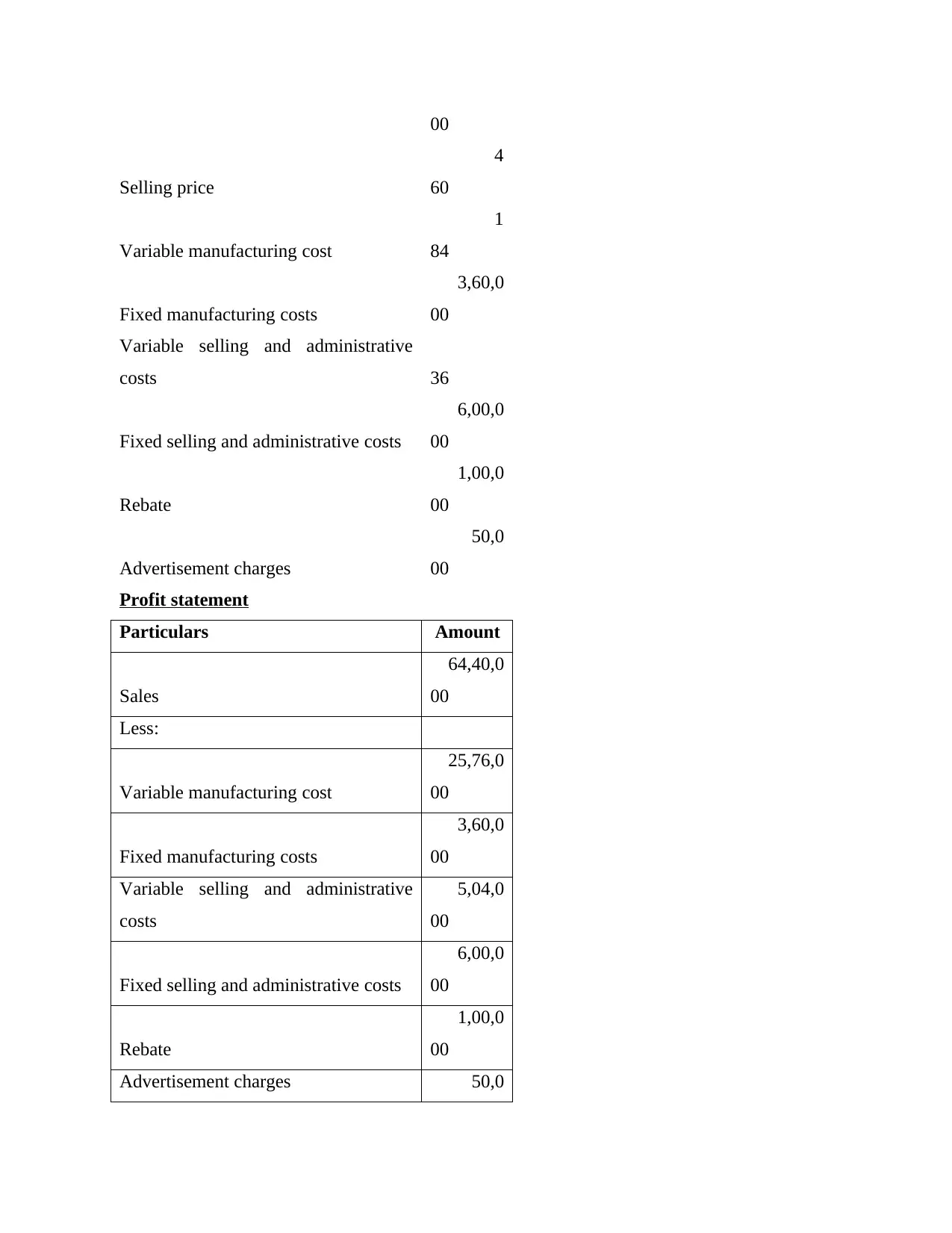
00
Selling price
4
60
Variable manufacturing cost
1
84
Fixed manufacturing costs
3,60,0
00
Variable selling and administrative
costs 36
Fixed selling and administrative costs
6,00,0
00
Rebate
1,00,0
00
Advertisement charges
50,0
00
Profit statement
Particulars Amount
Sales
64,40,0
00
Less:
Variable manufacturing cost
25,76,0
00
Fixed manufacturing costs
3,60,0
00
Variable selling and administrative
costs
5,04,0
00
Fixed selling and administrative costs
6,00,0
00
Rebate
1,00,0
00
Advertisement charges 50,0
Selling price
4
60
Variable manufacturing cost
1
84
Fixed manufacturing costs
3,60,0
00
Variable selling and administrative
costs 36
Fixed selling and administrative costs
6,00,0
00
Rebate
1,00,0
00
Advertisement charges
50,0
00
Profit statement
Particulars Amount
Sales
64,40,0
00
Less:
Variable manufacturing cost
25,76,0
00
Fixed manufacturing costs
3,60,0
00
Variable selling and administrative
costs
5,04,0
00
Fixed selling and administrative costs
6,00,0
00
Rebate
1,00,0
00
Advertisement charges 50,0
Paraphrase This Document
Need a fresh take? Get an instant paraphrase of this document with our AI Paraphraser
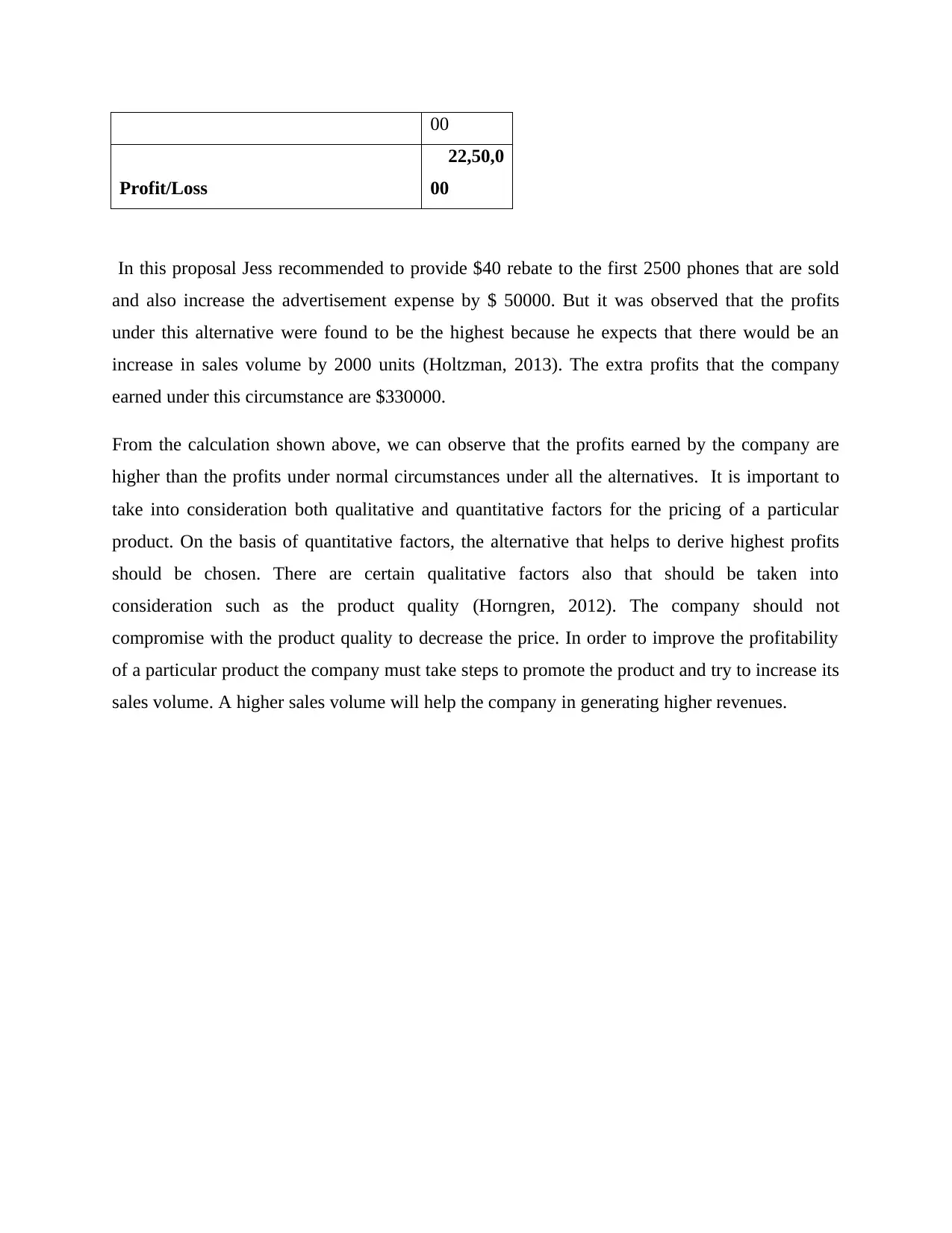
00
Profit/Loss
22,50,0
00
In this proposal Jess recommended to provide $40 rebate to the first 2500 phones that are sold
and also increase the advertisement expense by $ 50000. But it was observed that the profits
under this alternative were found to be the highest because he expects that there would be an
increase in sales volume by 2000 units (Holtzman, 2013). The extra profits that the company
earned under this circumstance are $330000.
From the calculation shown above, we can observe that the profits earned by the company are
higher than the profits under normal circumstances under all the alternatives. It is important to
take into consideration both qualitative and quantitative factors for the pricing of a particular
product. On the basis of quantitative factors, the alternative that helps to derive highest profits
should be chosen. There are certain qualitative factors also that should be taken into
consideration such as the product quality (Horngren, 2012). The company should not
compromise with the product quality to decrease the price. In order to improve the profitability
of a particular product the company must take steps to promote the product and try to increase its
sales volume. A higher sales volume will help the company in generating higher revenues.
Profit/Loss
22,50,0
00
In this proposal Jess recommended to provide $40 rebate to the first 2500 phones that are sold
and also increase the advertisement expense by $ 50000. But it was observed that the profits
under this alternative were found to be the highest because he expects that there would be an
increase in sales volume by 2000 units (Holtzman, 2013). The extra profits that the company
earned under this circumstance are $330000.
From the calculation shown above, we can observe that the profits earned by the company are
higher than the profits under normal circumstances under all the alternatives. It is important to
take into consideration both qualitative and quantitative factors for the pricing of a particular
product. On the basis of quantitative factors, the alternative that helps to derive highest profits
should be chosen. There are certain qualitative factors also that should be taken into
consideration such as the product quality (Horngren, 2012). The company should not
compromise with the product quality to decrease the price. In order to improve the profitability
of a particular product the company must take steps to promote the product and try to increase its
sales volume. A higher sales volume will help the company in generating higher revenues.
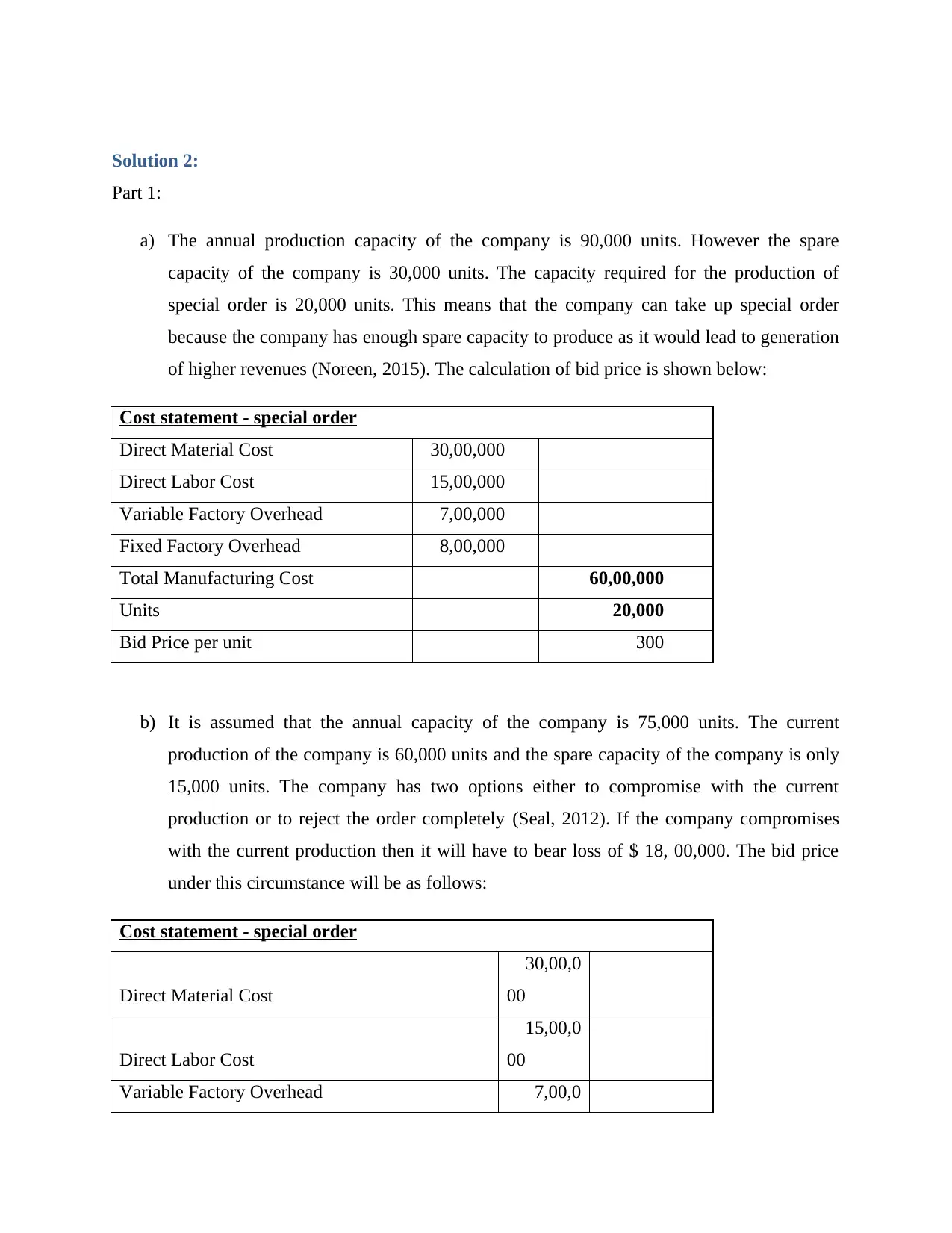
Solution 2:
Part 1:
a) The annual production capacity of the company is 90,000 units. However the spare
capacity of the company is 30,000 units. The capacity required for the production of
special order is 20,000 units. This means that the company can take up special order
because the company has enough spare capacity to produce as it would lead to generation
of higher revenues (Noreen, 2015). The calculation of bid price is shown below:
Cost statement - special order
Direct Material Cost 30,00,000
Direct Labor Cost 15,00,000
Variable Factory Overhead 7,00,000
Fixed Factory Overhead 8,00,000
Total Manufacturing Cost 60,00,000
Units 20,000
Bid Price per unit 300
b) It is assumed that the annual capacity of the company is 75,000 units. The current
production of the company is 60,000 units and the spare capacity of the company is only
15,000 units. The company has two options either to compromise with the current
production or to reject the order completely (Seal, 2012). If the company compromises
with the current production then it will have to bear loss of $ 18, 00,000. The bid price
under this circumstance will be as follows:
Cost statement - special order
Direct Material Cost
30,00,0
00
Direct Labor Cost
15,00,0
00
Variable Factory Overhead 7,00,0
Part 1:
a) The annual production capacity of the company is 90,000 units. However the spare
capacity of the company is 30,000 units. The capacity required for the production of
special order is 20,000 units. This means that the company can take up special order
because the company has enough spare capacity to produce as it would lead to generation
of higher revenues (Noreen, 2015). The calculation of bid price is shown below:
Cost statement - special order
Direct Material Cost 30,00,000
Direct Labor Cost 15,00,000
Variable Factory Overhead 7,00,000
Fixed Factory Overhead 8,00,000
Total Manufacturing Cost 60,00,000
Units 20,000
Bid Price per unit 300
b) It is assumed that the annual capacity of the company is 75,000 units. The current
production of the company is 60,000 units and the spare capacity of the company is only
15,000 units. The company has two options either to compromise with the current
production or to reject the order completely (Seal, 2012). If the company compromises
with the current production then it will have to bear loss of $ 18, 00,000. The bid price
under this circumstance will be as follows:
Cost statement - special order
Direct Material Cost
30,00,0
00
Direct Labor Cost
15,00,0
00
Variable Factory Overhead 7,00,0
⊘ This is a preview!⊘
Do you want full access?
Subscribe today to unlock all pages.

Trusted by 1+ million students worldwide
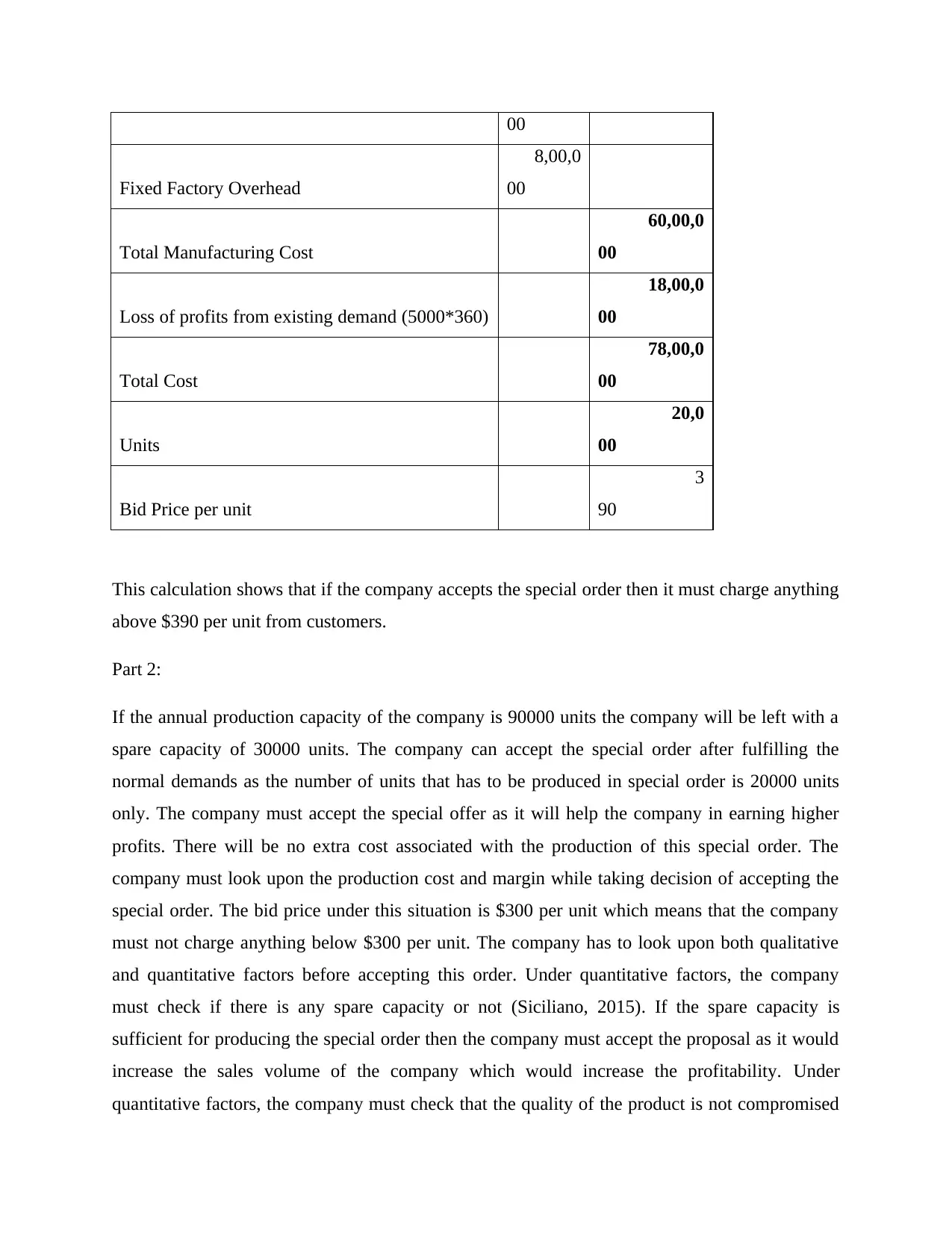
00
Fixed Factory Overhead
8,00,0
00
Total Manufacturing Cost
60,00,0
00
Loss of profits from existing demand (5000*360)
18,00,0
00
Total Cost
78,00,0
00
Units
20,0
00
Bid Price per unit
3
90
This calculation shows that if the company accepts the special order then it must charge anything
above $390 per unit from customers.
Part 2:
If the annual production capacity of the company is 90000 units the company will be left with a
spare capacity of 30000 units. The company can accept the special order after fulfilling the
normal demands as the number of units that has to be produced in special order is 20000 units
only. The company must accept the special offer as it will help the company in earning higher
profits. There will be no extra cost associated with the production of this special order. The
company must look upon the production cost and margin while taking decision of accepting the
special order. The bid price under this situation is $300 per unit which means that the company
must not charge anything below $300 per unit. The company has to look upon both qualitative
and quantitative factors before accepting this order. Under quantitative factors, the company
must check if there is any spare capacity or not (Siciliano, 2015). If the spare capacity is
sufficient for producing the special order then the company must accept the proposal as it would
increase the sales volume of the company which would increase the profitability. Under
quantitative factors, the company must check that the quality of the product is not compromised
Fixed Factory Overhead
8,00,0
00
Total Manufacturing Cost
60,00,0
00
Loss of profits from existing demand (5000*360)
18,00,0
00
Total Cost
78,00,0
00
Units
20,0
00
Bid Price per unit
3
90
This calculation shows that if the company accepts the special order then it must charge anything
above $390 per unit from customers.
Part 2:
If the annual production capacity of the company is 90000 units the company will be left with a
spare capacity of 30000 units. The company can accept the special order after fulfilling the
normal demands as the number of units that has to be produced in special order is 20000 units
only. The company must accept the special offer as it will help the company in earning higher
profits. There will be no extra cost associated with the production of this special order. The
company must look upon the production cost and margin while taking decision of accepting the
special order. The bid price under this situation is $300 per unit which means that the company
must not charge anything below $300 per unit. The company has to look upon both qualitative
and quantitative factors before accepting this order. Under quantitative factors, the company
must check if there is any spare capacity or not (Siciliano, 2015). If the spare capacity is
sufficient for producing the special order then the company must accept the proposal as it would
increase the sales volume of the company which would increase the profitability. Under
quantitative factors, the company must check that the quality of the product is not compromised
Paraphrase This Document
Need a fresh take? Get an instant paraphrase of this document with our AI Paraphraser
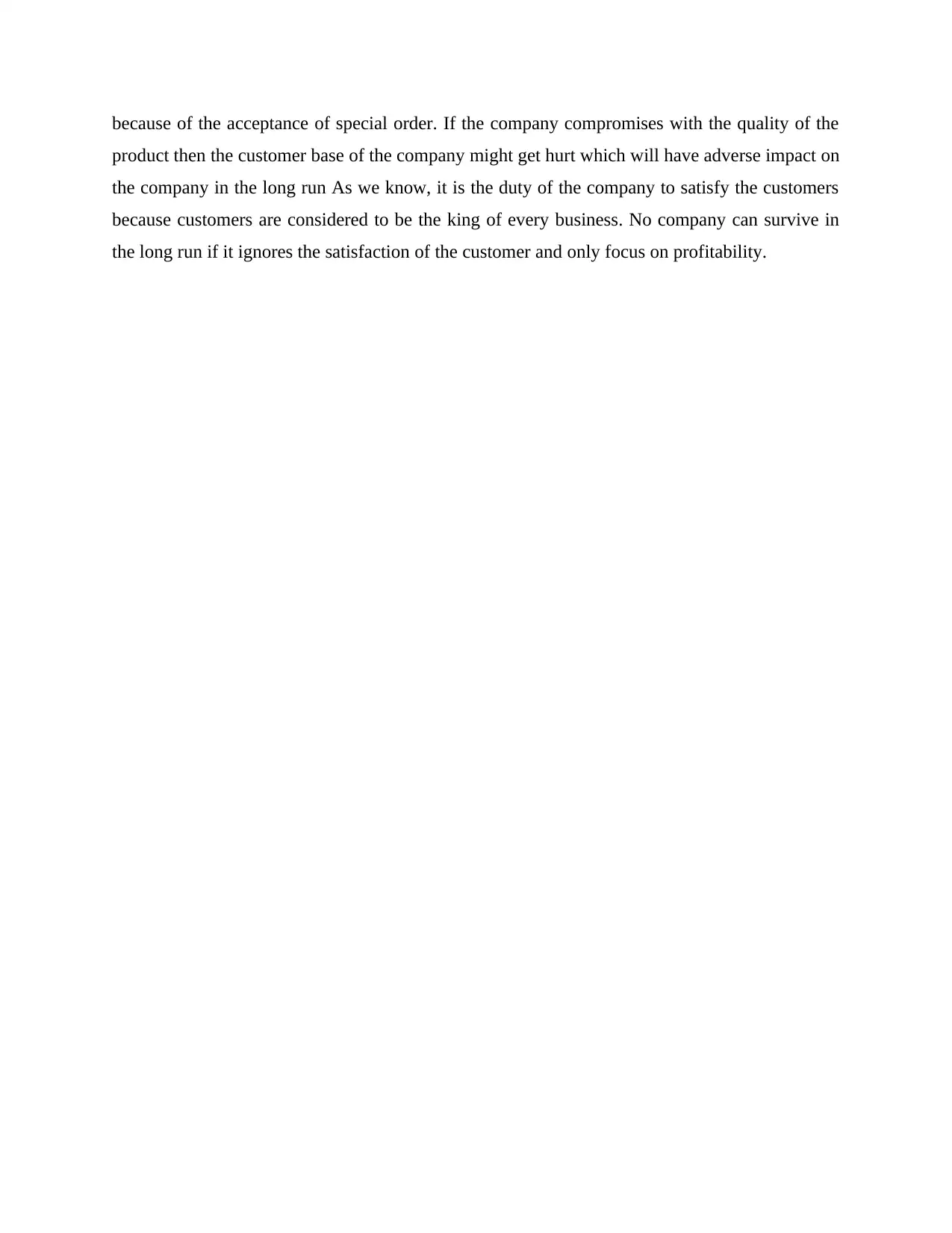
because of the acceptance of special order. If the company compromises with the quality of the
product then the customer base of the company might get hurt which will have adverse impact on
the company in the long run As we know, it is the duty of the company to satisfy the customers
because customers are considered to be the king of every business. No company can survive in
the long run if it ignores the satisfaction of the customer and only focus on profitability.
product then the customer base of the company might get hurt which will have adverse impact on
the company in the long run As we know, it is the duty of the company to satisfy the customers
because customers are considered to be the king of every business. No company can survive in
the long run if it ignores the satisfaction of the customer and only focus on profitability.
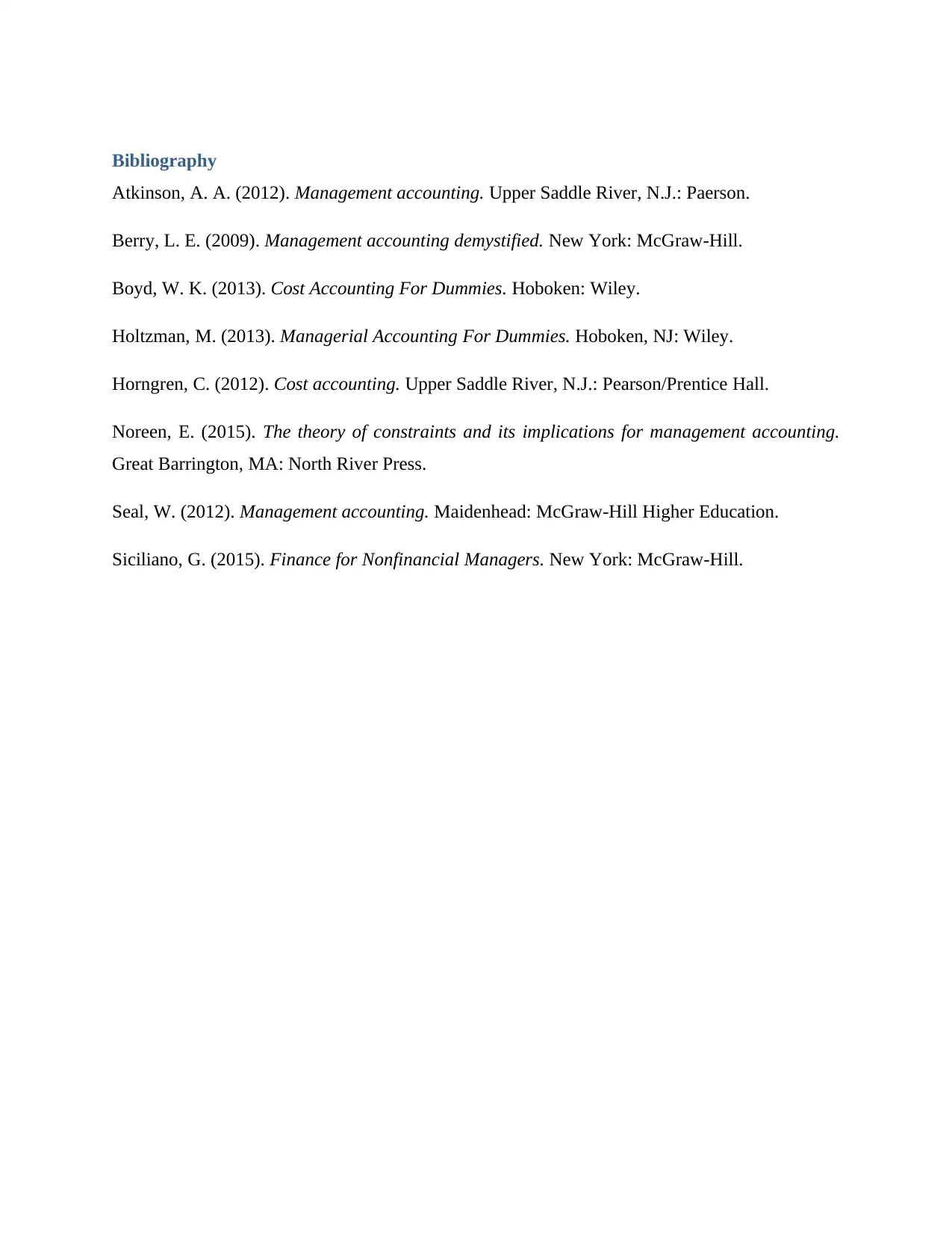
Bibliography
Atkinson, A. A. (2012). Management accounting. Upper Saddle River, N.J.: Paerson.
Berry, L. E. (2009). Management accounting demystified. New York: McGraw-Hill.
Boyd, W. K. (2013). Cost Accounting For Dummies. Hoboken: Wiley.
Holtzman, M. (2013). Managerial Accounting For Dummies. Hoboken, NJ: Wiley.
Horngren, C. (2012). Cost accounting. Upper Saddle River, N.J.: Pearson/Prentice Hall.
Noreen, E. (2015). The theory of constraints and its implications for management accounting.
Great Barrington, MA: North River Press.
Seal, W. (2012). Management accounting. Maidenhead: McGraw-Hill Higher Education.
Siciliano, G. (2015). Finance for Nonfinancial Managers. New York: McGraw-Hill.
Atkinson, A. A. (2012). Management accounting. Upper Saddle River, N.J.: Paerson.
Berry, L. E. (2009). Management accounting demystified. New York: McGraw-Hill.
Boyd, W. K. (2013). Cost Accounting For Dummies. Hoboken: Wiley.
Holtzman, M. (2013). Managerial Accounting For Dummies. Hoboken, NJ: Wiley.
Horngren, C. (2012). Cost accounting. Upper Saddle River, N.J.: Pearson/Prentice Hall.
Noreen, E. (2015). The theory of constraints and its implications for management accounting.
Great Barrington, MA: North River Press.
Seal, W. (2012). Management accounting. Maidenhead: McGraw-Hill Higher Education.
Siciliano, G. (2015). Finance for Nonfinancial Managers. New York: McGraw-Hill.
⊘ This is a preview!⊘
Do you want full access?
Subscribe today to unlock all pages.

Trusted by 1+ million students worldwide
1 out of 12
Related Documents
Your All-in-One AI-Powered Toolkit for Academic Success.
+13062052269
info@desklib.com
Available 24*7 on WhatsApp / Email
![[object Object]](/_next/static/media/star-bottom.7253800d.svg)
Unlock your academic potential
Copyright © 2020–2025 A2Z Services. All Rights Reserved. Developed and managed by ZUCOL.





